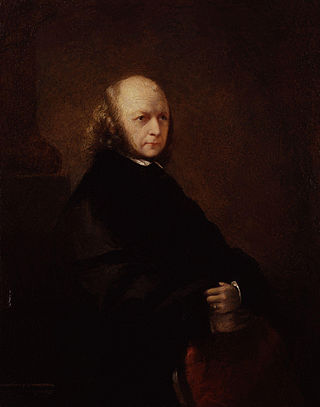Related Research Articles

Richard Hengist Horne was an English poet and critic most famous for his poem Orion.

Melbourne Town Hall, often referred to as simply Town Hall, is the administrative seat of the local municipality of the City of Melbourne and the primary offices of the Lord Mayor and city councillors of Melbourne. Located on the northeast corner of Swanston and Collins street in the central business district of Melbourne, Victoria, Australia, the building was completed in 1887 and heritage listed on the Victorian Heritage Register in 1974. The building is frequently used for art and cultural events such as concerts, festivals, theatrical plays and exhibitions.

The Athenaeum or Melbourne Athenaeum at 188 Collins Street is an art and cultural hub in the central business district of Melbourne, Victoria, Australia. Founded in 1839, it is the city's oldest cultural institution.
Tahbilk Winery is a historic Australian winery with National Trust certification. It is located 120 km (75 mi) north of Melbourne between the townships of Seymour and Nagambie in the Nagambie Lakes a sub region of Goulburn Valley Wine Region. It was established in 1860, and is the oldest family-owned winery and vineyard in Victoria. In 2022 it was ranked the eighteenth largest Australian wine company by production, and the tenth largest in terms of total revenue. The winery is part of Australia's First Families of Wine, a prominent Australian wine alliance.
The Sick Stockrider is a 1913 film directed by W. J. Lincoln based on the 1870 poem of the same title by Adam Lindsay Gordon. It was the first production from Lincoln-Cass Films and is one of the few Australian silent films to survive in its entirety.
James Henderson was a Scottish-born Presbyterian minister in Victoria and South Australia who was twice removed from his church after allegations of misconduct.
James Hazel Adamson was a machinist and inventor, better known for his paintings and engravings of marine subjects in the early days of colonization of South Australia.
The Melbourne Garrick Club was an association of people with interests in the theatre, founded in 1855, and disbanded around 1866 after the death of one of its "leading lights".
The Haymarket Theatre, or Royal Haymarket Theatre was a live theatre built by George Coppin in the Haymarket district of Melbourne, Australia in 1862 and was destroyed by fire in 1871.
Frederick Charles Appleton was an Australian actor, noted as a Shakespearean character actor, a "painstaking studious aspirant for histrionic honours", praised for his "considerable ability and tact". In 1883 he earned an academic degree and became a university lecturer, an unusual conjugation of careers, shared with H. B. Irving.
William Hoskins was a Shakespearean actor from England whose later career was mostly in Australia and New Zealand, reputedly "one of the best actors who has ever trod our stage".
Robert Percy Whitworth was a journalist, writer, and editor active in Australia and New Zealand.

Pegg Clarke was an Australian professional fashion, portrait, architectural and society photographer whose work, published frequently in magazines, was referred to by historian Jack Cato as being of "the highest standard."
Frederick George Younge was an English comic actor, in Australia for six years.
George Benjamin William Lewis commonly referred to as G. B. W. Lewis, or G. B. Lewis, was an English circus performer, later a circus and theatre entrepreneur in Australia. He married in 1864 the actress and playwright Rose Edouin.
Edgar Ray was an English entrepreneur who launched two magazines in Australia, Melbourne Punch and Sydney Punch. On his return to England, he is credited with founding another, named Touchstone or The New Era.
Joseph Charles Lambert, generally referred to as J. C. Lambert, was an English comic actor who had a significant career in Australia.

Annie Rattray Rentoul was an Australian lyricist and children's poet and story writer, best known for books illustrated by her younger sister, Ida Rentoul Outhwaite.
Grenville College was a small non-sectarian private school in Ballarat, Victoria. Although those enrolled were predominantly boys, at least one, quite notable, student was female.
References
- ↑ "ROBERT HENRY HORNE". Leader . Vol. XIV, no. 601. Victoria, Australia. 6 July 1867. p. 24. Retrieved 5 May 2024– via National Library of Australia.
- ↑ "My Bookshelves". Freeman's Journal . Vol. LXXI, no. 3678. New South Wales, Australia. 23 January 1919. p. 5. Retrieved 5 May 2024– via National Library of Australia.
- ↑ "No title". The Herald . Vol. LXXVII, no. 6502. Victoria, Australia. 23 October 1866. p. 2. Retrieved 5 May 2024– via National Library of Australia.
- ↑ "THE EXHIBITION". The Argus (Melbourne) . No. 6, 359. Victoria, Australia. 24 October 1866. p. 5. Retrieved 5 May 2024– via National Library of Australia.
- ↑ "OPENING OF THE EXHIBITION". The Argus (Melbourne) . No. 6, 360. Victoria, Australia. 25 October 1866. p. 5. Retrieved 5 May 2024– via National Library of Australia.
- ↑ "THE INTERCOLONIAL EXHIBITION". The Age . No. 3, 740. Victoria, Australia. 25 October 1866. p. 5. Retrieved 5 May 2024– via National Library of Australia.
- ↑ "MONDAY, APRIL 8, 1867". The Argus (Melbourne) . No. 6, 500. Victoria, Australia. 8 April 1867. p. 4. Retrieved 5 May 2024– via National Library of Australia.
- ↑ "REVIEW". Launceston Examiner . Vol. XXVII, no. 112. Tasmania, Australia. 1 August 1867. p. 4. Retrieved 5 May 2024– via National Library of Australia.